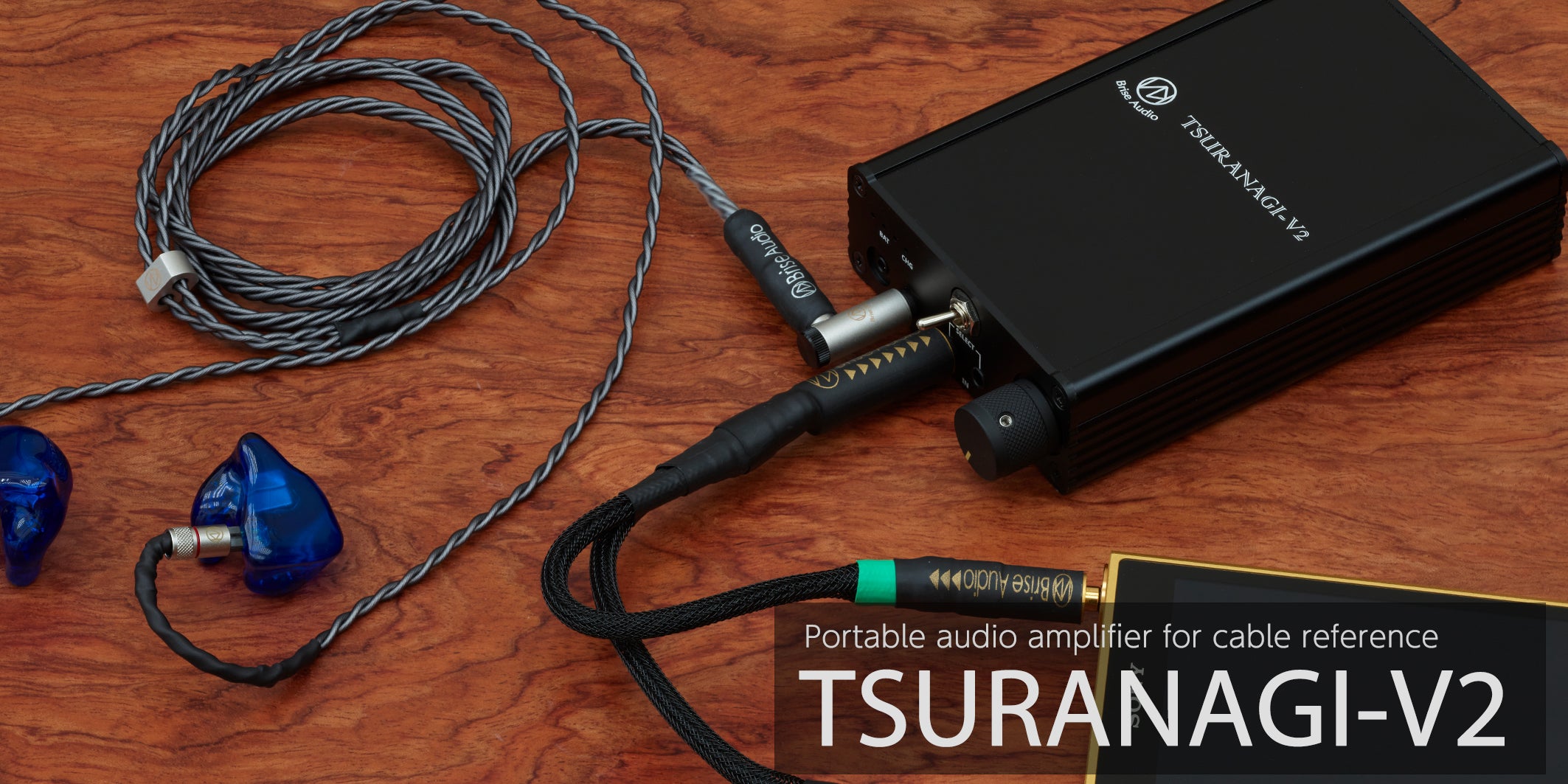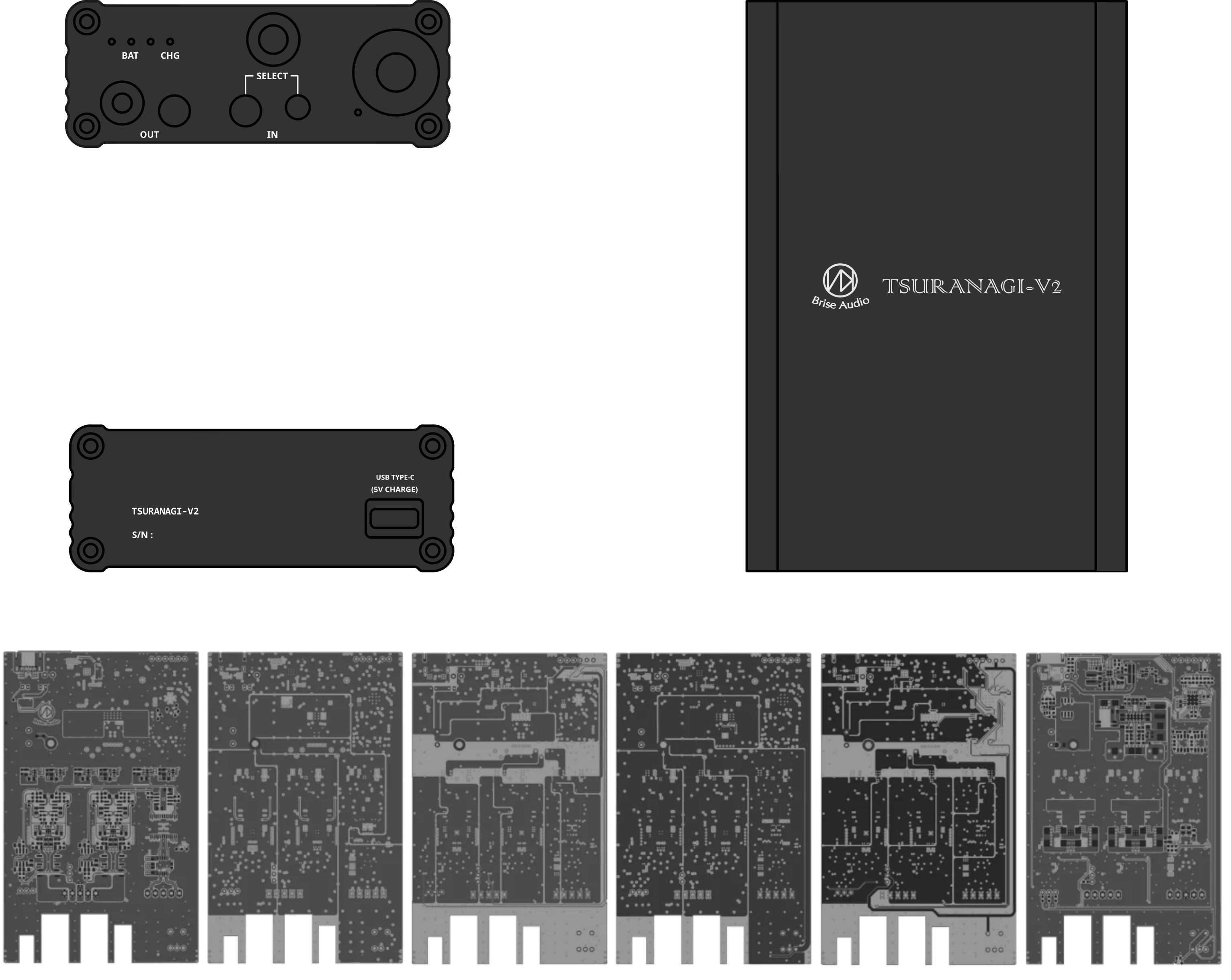
TSURANAGI-V2 Portable amplifier: open price (actual price 400,000 yen including tax)
TSURANAGI-V2 is a Version 2 model improved based on feedback obtained from TSURANAGI.
Noise level has been halved and improved to play more subtle sounds.
The three main changes are "6dB reduction in gain," "volume curve change," and "change to laser engraving.
1. 6dB reduction in gainPurpose: Reduction of residual noise
New resistors with different values are used.
This lowers the gain level and makes noise less perceptible even with highly sensitive earphones.
The gain was reduced from 10.5 dB to 4.5 dB, resulting in a 45% reduction in noise.
Although the lower gain makes it more difficult to maintain sound pressure, modern players have high output, so we judged this to be sufficient.
At 10.5 dB, the gain was set high because it was assumed that headphones of several hundred ohms could be used with low-power players.
2. volume curve changePurpose: Improve ease of volume adjustment
Previously, the curve went up quickly in the low volume range, but it was changed to a linear curve because it is sometimes difficult to adjust with highly sensitive earphones. The minimum and maximum volume levels remain unchanged.

3. change to laser engravingPurpose: Improve printing durability
The conventional printing on the case had a tendency to be chipped off; TSURANAGI-V2 is laser-engraved, which greatly improves durability.
The printing design has also been changed to make it simpler.
The TSURANAGI portable amplifier was developed as an evaluation device for the development of BriseAudio's high-end earphone cables and high-end portable line cables (mini-mini cables) in order to create an ideal portable audio environment. BriseAudio cables are used for internal wiring, and the electromagnetic wave absorbing shielding material and CNT (carbon nanotube) used in our high-end cables such as MURAKUMO and YATONO are installed on the board to further improve the sound quality.
【News】
※TSURANAGI after-sales service is now available, including information on upgrade plans to V2 and refresh plans.
※※Q&A about TSURANAGI is set up. We hope you will find this information useful, whether before or after your purchase.
※A detailed review of TSURANAGI was published in Head-Fi.
※We do not repair modified products. We do not provide parts.
Overview
◆Portable amplifier with analog input and output (for earphones and headphones)
◆Balanced input/output
◆Balanced output for unbalanced input signals
◆Pentaconn 4.4mm terminal mounted
◆Input: Balanced/unbalanced (5-pole 4.4mm + 3-pole 3.5mm)
◆Output: Balanced (5-pole 4.4mm + 4-pole 2.5mm)
◆High quality sound electronic volume IC MUSES72320 installed
◆Low noise differential line receiver for high input impedance & high common mode noise rejection
◆Low-noise all-differential operational amplifier for unbalanced-to-balanced conversion
◆Low distortion current feedback amplifier to drive headphones
◆Dual power supply and DC servo eliminates input/output coupling capacitors
◆Charging from USB Type C
◆Continuous playback time: approx. 8h (varies depending on the environment of use)
◆TSURANAGI-V2 reduces gain by 6dB and noise by 45%
◆TSURANAGI-V2 has a new volume curve to improve the ease of volume adjustment in the low volume range.
◆TSURANAGI-V2 is now laser-engraved, greatly improving printing durability.
Click here for the latest manual (Japanese / English)
Product Concept
In response to the recent increase in the number of players with balanced LINE OUT and balanced drive of headphones and earphones, Brise Audio has developed a portable amplifier with ideal balanced input/output for the development of mini-mini cables and re-cables.
To allow connection to conventional players, an unbalanced 3.5mm 3-pole input is also provided, which is internally converted to a high-precision balanced signal before being output.
Both 5-pole 4.4mm and 4-pole 2.5mm output terminals are provided. The design is based on low distortion and low noise, with the theme of expressing all the information of the source.
Low performance of any of the circuits from input to output will result in poor overall performance, so low distortion and low noise circuits and components are used in all signal processing circuits.
The high input impedance of 1MΩ also minimizes distortion of the upstream player output.
The differential line receiver precisely unbalances the balanced signal once and eliminates extraneous noise, enabling clean playback even in noisy outdoor environments.
The key composite amplifier in this amplifier simultaneously performs unbalanced-to-balanced conversion and current amplification.
Distortion is further reduced by including a current feedback amplifier in the feedback loop of all differential operational amplifiers.
The power supply circuit uses ultra-low noise & ultra-high PSRR regulators and is supplied independently to each channel.
A 6-layer board is used to eliminate common impedance and improve signal quality in terms of layout.
TSURANAGI-V2, as with the development of our cables, has a high output, wide bandwidth, no sound distortion, low noise floor, and a low noise floor.
Furthermore, we design for sound quality and performance with the guideline of minimizing the effects of the external environment and extracting as much performance from the equipment as possible.
TSURANAGI is a reference for our cable development environment, and we aimed to create an amplifier that would not spoil the performance and sound quality of the cable.
Cables are also designed to avoid bottlenecks in the equipment, so the aim is to further improve them in-house.

Other innovations regarding the amplifier were to set the amplifier bandwidth from 2 Hz to 200 kHz to ensure flat reproduction in the audible bandwidth of 20 Hz to 20 kHz.
The differential DC servo amplifier detects the differential DC of the balanced output and returns it to all differential operational amplifiers so that the offset is zero.
This allows the output DC offset to be suppressed to +/-50µV and eliminates coupling capacitors on the input side.
The OPAMP used in the DC servo amplifier is also an ultra-high-performance, low-noise product that does not degrade the sound quality.
In the unlikely event of a DC offset, the on-board microcontroller will detect it and protect the earphones.
All power supply decoupling capacitors for circuits that perform signal processing are film capacitors and conductive polymer aluminum capacitors.
For sound quality, all components are carefully examined and employed without regard to cost.

Independent power supply circuits are installed to ensure thorough separation between Lch and Rch and to provide sufficient power supply capacity.
Switching regulators and linear regulators by themselves have a generous current capability relative to the maximum rating of the amplifier.
On top of that, the regulator is designed as an independent supply, so it can follow momentary current consumption.
Both power supplies are generated from the battery power supply using a switching regulator. The switching frequency of 2 MHz and the large output capacitor are designed to provide very low noise for a switching regulator.
The purpose of generating both power supplies is to eliminate coupling capacitors on the output side and provide low distortion operation due to the higher supply voltage.
Operational amplifiers are generally operated at +/-15V, but since power loss cannot be ignored if the voltage is boosted to this level, +/-9.3V was used to ensure battery life.
An ultra-high-performance linear regulator is provided in the stage after the switching regulator to thoroughly eliminate residual switching noise and achieve low-noise reproduction.
These linear regulators are capable of rejecting noise down to the high-frequency bandwidth, so even 2 MHz switching noise is reliably removed.
Two of the six layers are used for power supply, and the layers are separated by positive and negative, with a GND layer in between to prevent interference.
As with the power supply, GND wiring is also routed on a plane to reduce impedance, while signal GND and power GND are separated not only between channels but also within a channel to the point where they intersect at a single point to ensure thorough separation.
It is grounded to the aluminum chassis at a single point to eliminate GND loops while suppressing external electromagnetic interference.

REASONS FOR UNBALANCED CONVERSION CONFIGURATIONS
◆In developing a portable amplifier with the ideal sound quality, Brise Audio's goal was to express every bit of information from the source.
Therefore, in circuit design, the highest priority was placed on low distortion and low noise, and thorough common-mode noise elimination was also focused on to achieve low noise.
◆As the product is expected to be used outdoors, the configuration with the most common-mode noise rejection was adopted to ensure constant and stable playback without interference from radio waves or other sources.
◆To achieve both low noise and low distortion, an ultra-low distortion audio differential line receiver with a high common-mode noise rejection ratio over a wide bandwidth is used for the common-mode noise rejection circuit.
◆We also intended to incorporate the electronic volume MUSES72320, which I feel has advantages in terms of performance and sound quality. One of the reasons is that the volume is converted to unbalanced in the first stage of the electronic volume to overcome the problem of different attenuation in the positive and negative circuits (although the error margin is small to begin with because it is an electronic volume).
◆In order to maximize the use of the limited resources of portable amplifiers, the unbalanced circuitry in the middle also allows for low power consumption and a large mounting area.
[Common mode noise]
Common mode noise is noise that travels in the same phase with respect to the signal.
Some are transmitted from the player to the cable, and some are transmitted from the space using the cable or other device as an antenna.
If the amplifier lacks common-mode noise rejection capability, noise will leak into the headphones even with a balanced amplifier.
You may feel this when the amplifier is placed close to a smartphone or a commercial power source; with TSURANAGI-V2, you will not hear such noise at all.
The general purpose of a balanced signal is that if noise is added during transmission (e.g., long cables), the noise can be canceled by taking the difference at the receiving end.
When taking the difference, it is most important that the common mode noise on the positive and negative signals have the same phase and the same amplitude.
As a cable, the two wires carrying the positive and negative signals are placed adjacent to each other by twisted pair or other means to pick up noise in the same phase and amplitude.
Twisted pairs also have a noise cancellation effect due to magnetic field cancellation, so they are often used for unbalanced signals.
The amplifier side is responsible for taking the difference between the balanced signals.
At that time, if the positive and negative signals are not differentiated with high precision, the cancellation effect will be weakened even though the signals are transmitted in balance.
When the amplifier actually takes the difference, it inverts the negative signal (even more negative) and adds it to the positive signal.
The gain at this point should not be disparate.
Therefore, the figure shows the case where TSURANAGI had an all-stage balanced configuration and the configuration of a product that performs unbalanced conversion.


If all stages were in a balanced configuration, it would be the headphones that would make the difference.
It goes through various amplifiers and volumes before reaching the headphones.
Therefore, when the signal reaches the headphones, the magnitudes of the positive and negative signals are slightly different, resulting in a weaker cancellation effect.
On the other hand, unbalanced conversion (taking the difference) in the first stage eliminates the degradation of common-mode noise rejection due to gain errors in the amplifiers and volume in the subsequent stages.
TSURANAGI uses the electronic volume MUSES72320, which matches orders of magnitude better than a typical variable volume.
However, in order to thoroughly eliminate common-mode noise, a differential line receiver with integrated high-precision matching resistors is used to take the difference before the volume, and then the signal is processed.
This means that the volume circuit and voltage amplification stage need only two channels, allowing for a spacious board layout and reduced power consumption. The resistors that make up the differential line receiver determine the gain when taking the difference.
It is important that the characteristics of this resistor and the internal OPAMP match in the positive and negative.
Even on unbalanced inputs, the differential line receiver receives single-ended signals as differential signals.
Because of its ability to cancel common mode noise on the signal line and GND, it has a noise advantage over amplifiers with general unbalanced inputs.
REASON FOR BALANCED CONVERSION AND OUTPUT
This is partly to achieve a balanced input/balanced output configuration, but there are several advantages to driving in balanced mode in the first place.
In order to make headphones sound, the amplifier must supply a lot of current.
Amplifiers are characterized by the fact that the more current they output, the more prone to distortion.
A balanced amplifier can cancel the even-order distortion that occurs in the headphones.
To digress, it is difficult to cancel odd-order distortion, and basically the only way is to use an amplifier (including its configuration) that does not generate odd-order distortion in the first place even when current is output.
To suppress odd-order distortion, TSURANAGI uses a composite (composite) amplifier configuration, in which the current feedback amplifier that outputs current is negatively feedbacked to suppress distortion by all differential amplifiers.
This operation also suppresses even-order distortion, so the overall distortion is even smaller.
Another reason is that it can output a large amplitude even with the limited supply voltage of a portable system.
With a single-ended amplifier, only the HOT side sends amplitude to the headphones, but with BTL, the amplifiers for HOT and COLD are both driven (exhaled and inhaled), so the maximum amplitude that can be sent to the headphones can be doubled for the same supply voltage.
Since the voltage is doubled, the current is also doubled, which is why a BTL amplifier can deliver four times more power than a single-ended one.
PRODUCT LINE-UP
▶ TSURANAGI-V2 (main unit only) Model number: PA002-S JAN: 4570113632888
A minimum earphone load impedance of 16 ohms is recommended.
We recommend listening to the product if it is less than 16 ohms. Although the product is designed to be driven sufficiently by headphones, some headphones with low performance may not be able to provide sufficient volume.
(The ADX5000, HD800, MDR-Z1R, Utopia, etc. are loud enough.)
We recommend the YATONO MINI LE or YATONO-MINI UltimateYATONO MINI LEかYATONO-MINI Ultimate as the mini-mini cable for balanced connection.
Compatibility table of mini-mini cables to be used in combination with TSURANAGI-V2 and each player.
This is an example of use with the balanced input of a portable amplifier fixed to a 4.4mm (5-pole) connection.
For other types of balanced inputs, please contact us.
| ◆4.4mm (player side / line output) to 4.4mm (portable amplifier) ※This is for use when the 4.4mm output on the player side has the GND (5-pole) connected. |
|---|
| Hiby |
| RS6, RS8, R5 II, R6 III, R6 Pro II, R8, NewR6, R5 (requires switching in the software) |
| Astell&Kern |
| KANN ALPHA(ソフト側で切り替えの必要あり), SP4000,SP3000, SR35, KANN MAX, SE180, SR25 MKII, SP2000T |
| FiiO |
| M11 Plus ESS, M11 Plus LTD, M15S, M17 |
| Shanling |
| M3X, M9 Plus |
| iBasso |
| DX320, DX300, AMP8MK2 |
| Luxury & Precision |
| LP6, P6PRO |
| Lotoo |
| PAW GT2, PAW Gold TOUCH, PAW Gold TOUCH Titanium, PAW 6000 |
| Cayin |
| N8ii, N8, N7, N3Pro, N6ii/E02, N6ii/T01, N6ii/A01 |
| ◆4.4mm & 3.5mm dual connection (player side / line output) to 4.4mm (portable amplifier) ※プレイヤー側4.4mm出力にGND(5極)が接続されていない場合はこちらです。 |
|---|
| SONY |
| NW-WM1ZM2, NW-WM1AM2, NW-WM1Z, NW-WM1A, NW-ZX500 series, NW-ZX300 series |
| ◆2.5mm & 3.5mm dual connection (player side / line output) to 4.4mm (portable amplifier) |
|---|
| Astell&Kern |
| SP3000, SR35, KANN MAX, SE180, KANN ALPHA, KANN CUBE, SP1000, SP1000M, SP2000, SE100, SE200, SR15, SR25, SA700
※AK製品はソフトウェア側でライン出力を指定する必要ございます。 ※Be sure to insert the 3.5mm plug first. If you insert the 2.5mm plug first, it will not switch to balanced line output mode. |
| ◆You can use it without any issues when connecting via unbalanced connection (3.5mm to 3.5mm). |
|---|
We recommend using a balanced 4.4mm to 4.4mm connection whenever possible.
For players equipped with 2.5mm, 4.4mm, and 3.5mm terminals, it may be possible to use either a split cable or a straight 4.4mm to 4.4mm cable with GND wiring. However, for better sound quality, we recommend using a straight 4.4mm to 4.4mm cable with GND wiring.
For Walkman devices, the GND of the 4.4mm terminal is not connected, so 4.4mm to 4.4mm cables with GND wiring cannot be used.
※OROCHI-MINI Ultimate does not support devices that require a 2.5mm + 3.5mm to 4.4mm connection.
※一覧に無い製品などご不明な点はお気軽にお問い合わせ下さい。 対応表は随時更新いたします。
TSURANAGI-V2 Specifications table
| Unbalanced | Balanced | |
|---|---|---|
| Input Terminal | 3-pole 3.5 mm | 5-pole 4.4 mm (GND connection) |
| Output Terminal | - | 5-pole 4.4 mm (GND connection) / 4-pole 2.5 mm |
| Voltage gain (volume maximum) | 4.5 dB |
|---|---|
| Max input level at Balanced input※ | 6Vrms / 3.5 Vrms |
| Max input level at Unbalanced input※ | 5Vrms / 3.5 Vrms |
| Frequency response (-3dB) | 2 Hz - 200 kHz |
| Recommended load impedance | 16 ohms or more (if less than 16 ohms, audition required) |
| Maximum output(16ohm, THD+N<0.01%) | 700 mW + 700 mW |
| Maximum output(32ohm, THD+N<0.01%) | 1000 mW + 1000 mW |
| Maximum output(300ohm, THD+N<0.01%) | 100 mW + 100 mW |
| THD+N (BW=20kHz, 1Vrms output,16ohm) | < 0.004 % |
| THD+N (BW=20kHz, 1Vrms output,300ohm) | < 0.001 % |
| THD+N (BW=20kHz, 3.4Vrms output, 300ohm) | < 0.0007 % |
| Crosstalk (20Hz - 20kHz) | < -100 dB |
| Battery life | 8 h |
| Dimensions (W x H x D), excluding protrusion | 80 mm x 30 mm x 120 mm |
| Charging terminal | USB Type-C |
| Battery capacity | 7.4 V 2800 mAh |
| Charging time | < 5 h (with 5 V2A AC adapter) |
| Mass | 360 g |
| Official Store |
※The clipping conditions are different when the volume is attenuated and when it is at its maximum. Basically, it is acceptable to refer to the time of attenuation.
Stores with TSURANAGI-V2 listening device
We are continually expanding the number of stores where you can audition our product. If there are no stores nearby where you can listen to our product, it is also possible to lend it directly (within Japan).
Despite the equipment being available, if the demo cables are not out in the store, please ask the store staff.
◆Fujiya Avic
3F Nakano Broadway, 5-52-15 Nakano, Nakano-ku, Tokyo 164-0001 TEL: 0120-189-248
◆e earphone Akihabara store
Kanda Eight Building 4F, 4-6-7 Sotokanda, Chiyoda-ku, Tokyo 101-0021 TEL: 03-3256-1701
CONTACT US
Please feel free to contact us, including inquiries about our products.
REQUEST A LISTENING TRIAL
This is a service that allows you to listen to the music in your own home. This service is available only for residents in Japan.
CLICK HERE TO PURCHASE
Go to the TSURANAGI-V2 purchase page.




